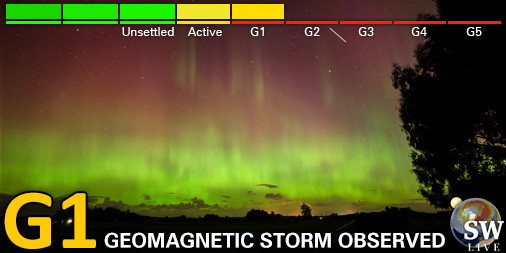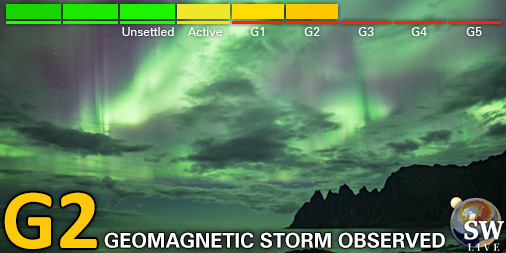Viewing archive of Monday, 10 May 2010
Solar activity report
Prepared by the NOAA © SWPC and processed by SpaceWeatherLive.com
Joint USAF/NOAA Report of Solar and Geophysical Activity
SDF Number 130 Issued at 2200Z on 10 May 2010IA. Analysis of Solar Active Regions and Activity from 09-2100Z to 10-2100Z
IB. Solar Activity Forecast
IIA. Geophysical Activity Summary 09-2100Z to 10-2100Z
IIB. Geophysical Activity Forecast
III. Event Probabilities 11 May to 13 May
| Class M | 01% | 01% | 01% |
| Class X | 01% | 01% | 01% |
| Proton | 01% | 01% | 01% |
| PCAF | green | ||
IV. Penticton 10.7 cm Flux
Observed 10 May 074 Predicted 11 May-13 May 075/075/075 90 Day Mean 10 May 081
V. Geomagnetic A Indices
Observed Afr/Ap 09 May 001/004 Estimated Afr/Ap 10 May 003/005 Predicted Afr/Ap 11 May-13 May 008/008-010/010-008/008
VI. Geomagnetic Activity Probabilities 11 May to 13 May
| A. Middle Latitudes | |||
|---|---|---|---|
| Active | 25% | 30% | 25% |
| Minor storm | 05% | 10% | 05% |
| Major-severe storm | 01% | 01% | 01% |
| B. High Latitudes | |||
|---|---|---|---|
| Active | 30% | 35% | 30% |
| Minor storm | 10% | 15% | 10% |
| Major-severe storm | 01% | 01% | 01% |
All times in UTC
Current data suggests there is a moderate possibility for aurora to appear at the following high latitude regions in the near future
Whitehorse, YTFairbanks, AK
Current data suggests there is a slight possibility for aurora to appear at the following high latitude regions in the near future
Edmonton, AB, Gillam, MB, Saskatoon, SK, Yellowknife, NTAnchorage, AK, Juneau, AK
Latest news
Latest forum messages
Support SpaceWeatherLive.com!
A lot of people come to SpaceWeatherLive to follow the Sun's activity or if there is aurora to be seen, but with more traffic comes higher server costs. Consider a donation if you enjoy SpaceWeatherLive so we can keep the website online!

Latest alerts
04:15 UTC - Geomagnetic activity
Minor G1 geomagnetic storm (Kp5) Threshold Reached: 04:05 UTC
03:15 UTC - Geomagnetic activity
Moderate G2 geomagnetic storm (Kp6) Threshold Reached: 02:59 UTC
01:00 UTC - Geomagnetic activity
Minor G1 geomagnetic storm (Kp5) Threshold Reached: 00:51 UTC
Friday, 4 April 2025
23:30 UTC - Geomagnetic activity
Minor G1 geomagnetic storm (Kp5) Threshold Reached: 23:17 UTC
21:03 UTC - Hemispheric Power Index
The OVATION model predicts the Hemispheric Power Index to reach 75GW at 21:49 UTC
Space weather facts
| Last X-flare | 2025/03/28 | X1.1 |
| Last M-flare | 2025/04/01 | M2.5 |
| Last geomagnetic storm | 2025/04/04 | Kp5+ (G1) |
| Spotless days | |
|---|---|
| Last spotless day | 2022/06/08 |
| Monthly mean Sunspot Number | |
|---|---|
| March 2025 | 134.2 -20.4 |
| April 2025 | 148 +13.8 |
| Last 30 days | 130.9 -15.2 |






